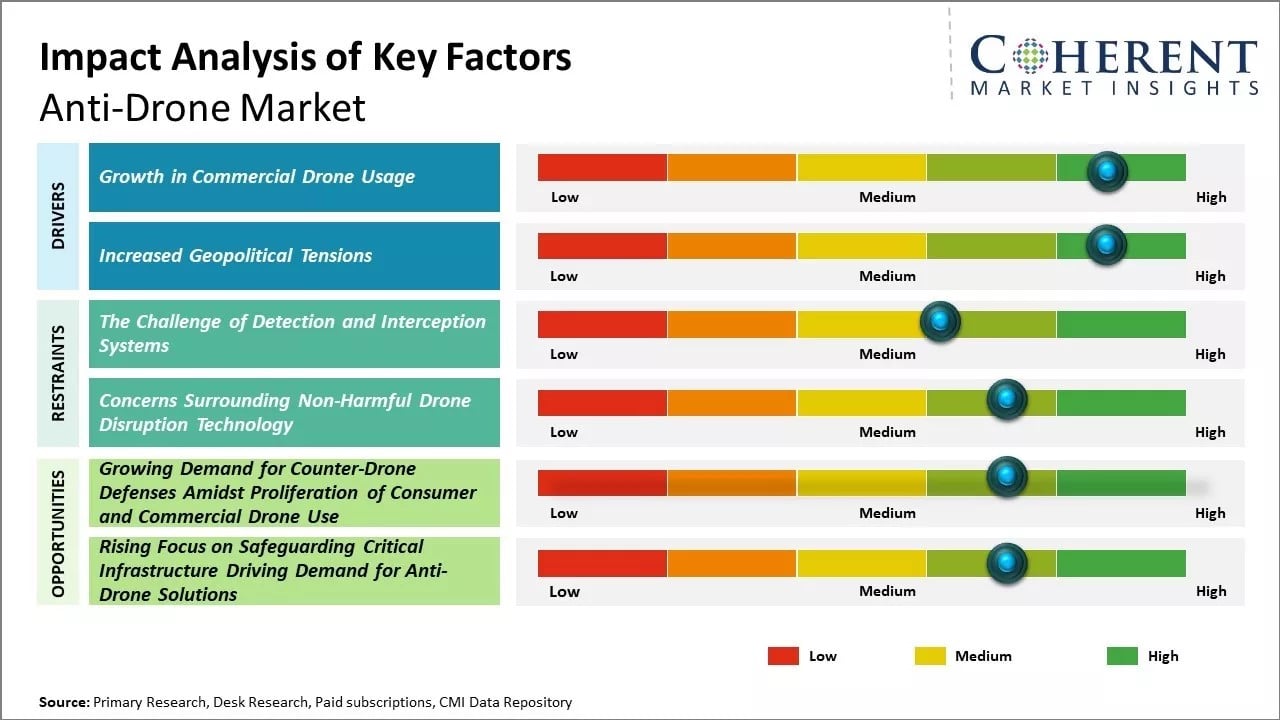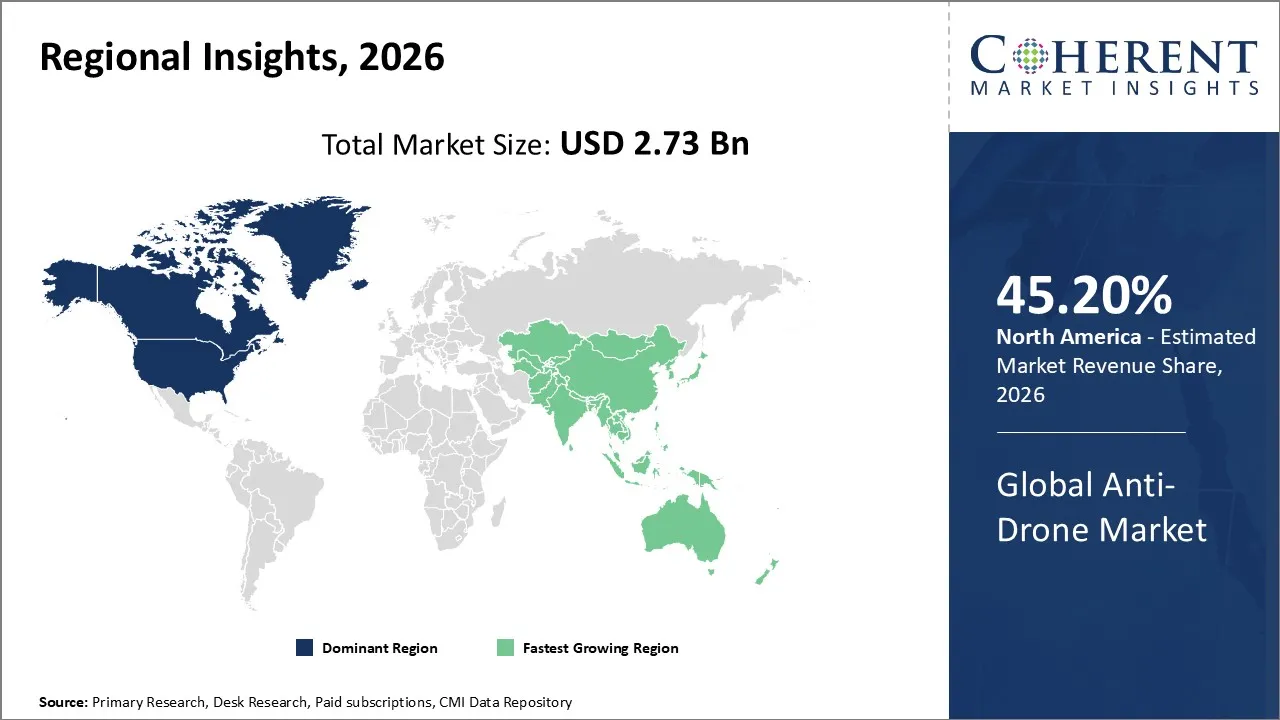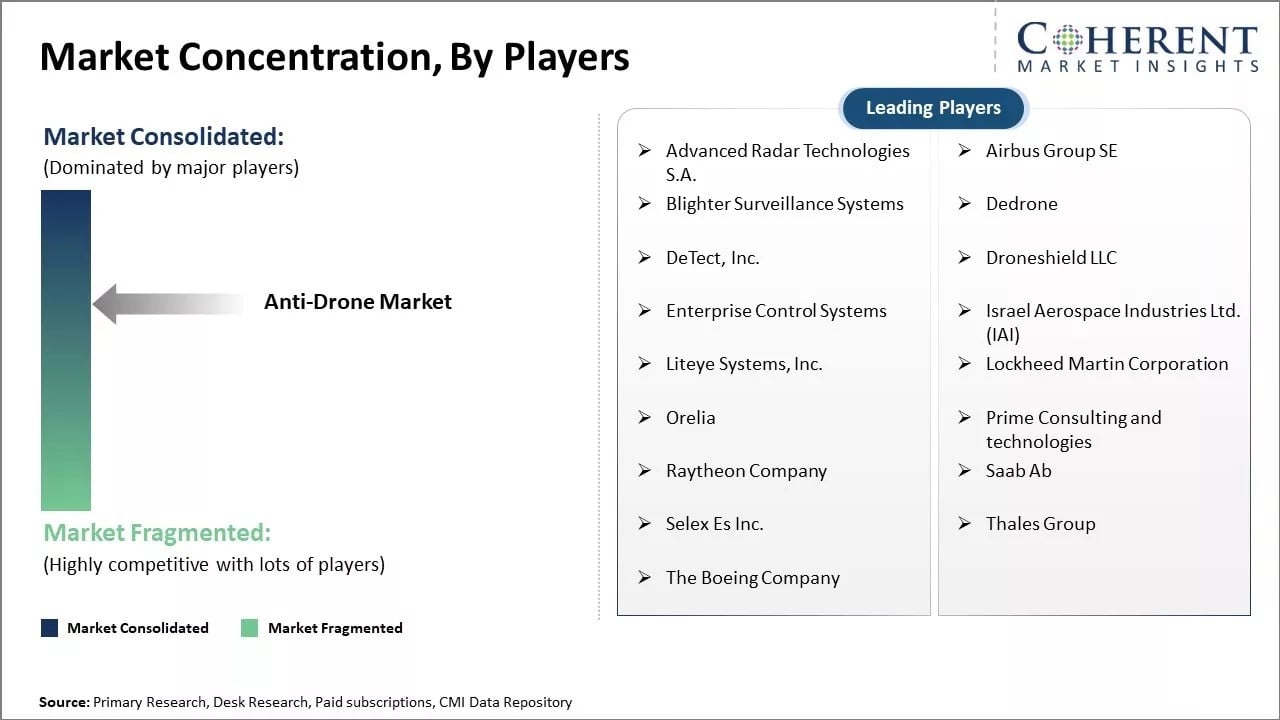The anti-drone market is estimated to be valued at USD 2.73 Bn in 2026 and is expected to reach USD 13.62 Bn by 2033, growing at a compound annual growth rate (CAGR) of 25.9% from 2026 to 2033.

To learn more about this report, Download Free Sample
The anti-drone market is expected to experience positive growth over the next few years. With the rising security threats from unidentified drones and increasing incidences of drone trespassing, the demand for anti-drone system is expected to rise significantly. Many government agencies and private end-users are planning to adopt counter drone technology to safeguard sensitive locations. Furthermore, advancement in AI and jamming technology will also support the market growth during the forecast period. However, spectrum interference issues and lack of coordinated counter-drone standards may impede the growth of the anti-drone market to some extent.
|
Current Event |
Description and its Impact |
|
Regulatory Framework Evolution and Standardization |
|
|
Technological Breakthroughs and AI Integration |
|
Uncover macros and micros vetted on 75+ parameters: Get instant access to report
Prices for anti-drone systems in 2026 vary widely depending on the technology, platform, and use. Police and security forces use handheld jammers that cost between $30,000 and $75,000. Ground-based radar and RF systems used at airports or stadiums cost between $500,000 and $3 million. Patrol systems that are mounted on vehicles cost between $1 and $2 million, while mobile defense platforms that use UAVs cost between $2 and $5 million. Advanced laser or hybrid systems made for the military can cost more than $10 million precisely due to the accuracy and scale. High costs are still a problem for businesses, but defense and homeland security keep driving up demand.
For instance, in December 2025, The Defence Acquisition Council of India approved ₹79,000 crore for new purchases, such as loitering munitions and anti-drone technologies. The investment makes the battlefield and national security stronger, which shows that India is committed to modernizing its defense infrastructure. This large spending shows how vital counter-drone systems are becoming in military strategy and getting ready for future wars.
In terms of components, hardware contributes the largest share of 78.6% in 2026, to the anti-drone market due to advancements in technologies. Hardware components are crucial for finding, identifying, and stopping rogue drones. Radar systems can find drones that are within range. Phased array and software-defined radar can even find small targets with high resolution, which makes them more useful for defense.
Thermal cameras detect drones at any time of day or night, and electro-optical and infrared sensors can detect them as well. Sensor fusion algorithms make radar and EO/IR systems work together to provide reliable redundant detection.
Radio frequency systems pick up signals from drone controllers and use wideband receivers and agile antennas to find pilots. Jammers, lasers, interceptors, and kinetic projectiles are all tools that can be used to neutralize something. Innovation in border security, intelligence, and rescue operations is driven by small, portable designs and government funding.
For instance, in December 2025, DroneShield obtained a $6.2 million contract to send counter-drone systems to the Asia-Pacific military. The deal shows that there is a growing need for anti-drone hardware like radars, RF sensors, and jammers. This shows that hardware is still the most important part of defense applications. This makes DroneShield's presence in the region stronger and shows that people all over the world are investing in technologies that help reduce drone threats.
Among platforms, ground-based systems are expected to account for the largest share of 67.5% in 2026 in the anti-drone market. Ground-based anti-drone systems are the main part of security for important assets and public events as they are stable and cover a wide area. Fixed stations are capable of tracking drones up to 10–15 km away, and mobile vehicles can strategically expand the perimeter. Ground systems, on the other hand, provide seamless surveillance with high transmission power and multiple sensors, so there are no blind spots.
This may not be the case with handheld or UAV-mounted radars. Hardwired infrastructure makes sure that centralized command has reliable power and networking. With effector payloads, they can track, jam, and neutralize targets from a distance. These systems are better than temporary ones because they are tough and work in rough terrain. This makes ground-based networks the main way for governments around the world to protect themselves.
For instance, in November 2025, Indrajaal Drone Defence, which is based in Hyderabad, has released the Anti-Drone Patrol Vehicle, a mobile ground-based platform that can find, track, and destroy drones. It protects sensitive areas and borders with AI-powered sensors and jamming systems. The vehicle expands the areas that can be watched, making ground-based systems even better at defending against drones in a variety of terrains and missions.

To learn more about this report, Download Free Sample
North America has established itself as the dominant region in the global anti-drone market and is expected to account for a market share of 45.2% in 2026. The U.S. accounts for the largest share owing to heavy defense spending and stringent regulations regarding drone security across critical infrastructure and national assets. Several U.S. government agencies such as Department of Homeland Security (DHS), Department of Defense (DOD), and Federal Aviation Administration (FAA) have implemented policies and issued guidelines necessitating the deployment of counter-drone technologies at airports, military bases, and other vital facilities.
For instance, in December 2025, The Science and Technology Directorate of the U.S. Department of Homeland Security worked with other government agencies to fight drone threats. The goal of the initiative is to improve technologies for detecting, tracking, and mitigating threats to critical infrastructure and public safety. This indicates the necessity it is for federal agencies to work together on anti-drone strategies.
The Asia Pacific region is emerging as the fastest growing market for anti-drone systems globally with a CAGR of 29.09% in 2026. Countries like China, India, and Japan are aggressively focusing on countering the menace of unidentified or rogue drones around important locations. Rapid economic expansion and development of smart cities in these nations have stimulated the requirement for reliable drone detection and security solutions. Additionally, increasing drone imports and indigenous drone manufacturing in the region have also raised concerns about airspace security. Local governments are proactively engaging with international anti-drone suppliers and encouraging joint ventures with domestic technology firms to address this challenge.
For instance, in December 2025, Indrajaal Drone Defense launched India's first Anti-Drone Patrol Vehicle, which is a mobile ground-based platform with radars, sensors, and jammers that use AI. It improves border security, public safety, and defense operations by being able to find, track, and neutralize drones in real time. This strengthens India's growing role in counter-drone innovation.
The U.S. anti-drone market will be highly robust in 2026 due to rising security threats from unauthorized drones, strong government investments in defense and homeland security, the need to protect airports and public places, and the need to protect important infrastructure and military assets.
For instance, in December 2025, the U.S. Space Force installed new technology to combat drones near launch sites at Cape Canaveral. The Air Force Research Laboratory and the National Reconnaissance Office worked together to make the system better at finding, following, and stopping unauthorized drones. This protects rocket launches, aerospace missions, and national security by giving the government better ways to defend against drones.
The market for anti-drone in China is expected to remain strong in 2026 on account of the growing threat of drones, the need to modernize the military, worries about border security, and the quick spread of UAVs in both civilian and business settings. To protect important infrastructure and national security, the Chinese government and military are spending an abundance of assets on counter-drone technologies.
For instance, in April 2025, China unveiled the world's first anti-drone barrage weapon to fight drone swarms and missile wars. The system uses advanced interception technology to take out several aerial threats at once, making the country's defenses stronger. This new technology shows how much China is spending on next-generation anti-drone systems to modernize its military and improve its strategic security operations.
| Report Coverage | Details | ||
|---|---|---|---|
| Base Year: | 2025 | Market Size in 2026: | USD 2.73 Bn |
| Historical Data for: | 2020 To 2024 | Forecast Period: | 2025 To 2032 |
| Forecast Period 2026 to 2033 CAGR: | 25.9% | 2033 Value Projection: | USD 13.62 Bn |
| Geographies covered: |
|
||
| Segments covered: |
|
||
| Companies covered: |
Advanced Radar Technologies S.A., Airbus Group SE, Blighter Surveillance Systems, Dedrone, DeTect, Inc., Droneshield LLC, Enterprise Control Systems, Israel Aerospace Industries Ltd. (IAI), Liteye Systems, Inc., Lockheed Martin Corporation, Orelia, Prime Consulting and technologies, Raytheon Company, Saab Ab, Selex Es Inc., Thales Group, and The Boeing Company |
||
| Growth Drivers: |
|
||
| Restraints & Challenges: |
|
||
Uncover macros and micros vetted on 75+ parameters: Get instant access to report
As drones are being used increasingly for commercial purposes like package deliveries, infrastructure inspections, agricultural monitoring, and film making, the need for reliable anti-drone systems is rising. E-commerce giants are actively working towards building drone fleets to deliver packages within cities in under 30 minutes. This could revolutionize last-mile delivery operations and make online shopping even more convenient. However, with increased commercial drone traffic in low-altitude airspace, the risk of possible misuse of these drones for sabotage or surveillance also rises. Key companies need assurances that unauthorized drones cannot interfere with their operations or steal sensitive data.
In the current world order marked by geopolitical conflicts and tensions between nations, proliferation of small drones poses serious challenges for national security. While drone technology progress has been rapid, mitigating rogue drone threats still remains a work in progress for militaries and law enforcement. There have been reported incidents of enemy drones striking nearby bases in ongoing border conflicts. At the same time, terrorist groups are also known to use off-the-shelf drones for surveillance and attacks. The threat landscape is continuously evolving as drone payloads expand to include explosives, chemical, and biological weapons. Furthermore, adversarial nations like North Korea and Iran have boosted their drone arsenal significantly.
The widespread consumer and commercial use of drones have highlighted the need for counter-drone defenses, especially around critical infrastructure. Governments and organizations are increasingly seeking solutions to monitor airspace and respond to potential drone threats. If international standards and guidelines can be established, it could help accelerate market acceptance and validation of anti-drone systems.

To learn more about this report, Download Free Sample
Share
Share
About Author
Suraj Bhanudas Jagtap is a seasoned Senior Management Consultant with over 7 years of experience. He has served Fortune 500 companies and startups, helping clients with cross broader expansion and market entry access strategies. He has played significant role in offering strategic viewpoints and actionable insights for various client’s projects including demand analysis, and competitive analysis, identifying right channel partner among others.
Missing comfort of reading report in your local language? Find your preferred language :
Transform your Strategy with Exclusive Trending Reports :
Frequently Asked Questions
Joining thousands of companies around the world committed to making the Excellent Business Solutions.
View All Our Clients